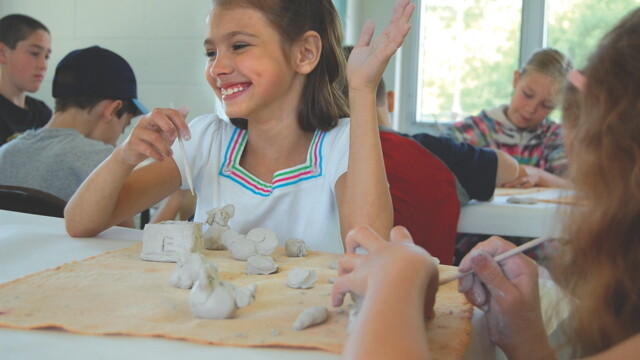Making Visual Art
the reinforcement power of learning through creating art
Katie Hoffman, photos by Hannah Hebl |

Whether or not they realize it, people of all ages benefit from art-rich lives. Especially when it comes to learning. Just ask an area art teacher about what a classroom lesson can do for enhancing other subjects. Long-time art teacher Pat Binder calls it “the cement of all subjects.”
Often visual art lessons will include elements of other subjects (history, geometry, etc.), and reinforce what they’ve already learned. That’s why those “core” subjects will often assign projects that involve presentations (theater) or visual representations (art).
“I think including some form of art within lessons heightens grades,” says Pam Henning, a teacher at Montessori Charter School. “I think it makes it more meaningful to students and they take pride in their work.”
In 2008, the state of Colorado released a report about its public schools that found a tight correlation between art classes and overall academic success. “Students who do well in reading, writing, and science attend schools that offer a rich and varied arts program – regardless of the students’ racial composition or socioeconomic status,” it stated.
Like many forms of art, it also boosts a sense of personal expression and communication. But most experts tout its benefits in divergent thinking and creative problem solving, because they don’t stigmatize and often have several ways to solve a problem. This creates an innate confidence as they dive into other subjects and new problems.
The Colorado study also found that “arts help keep students in school. Schools that scored high on the arts index had lower dropout rates. For many students, the arts are the crucial connection that motivates them to learn and gives them the confidence to tackle other subjects.”
VISUAL ARTS OPPORTUNITIES FOR KIDS
The Eau Claire Children’s Museum’s (220 S Barstow St.) goal is to provide an interactive environment to inspire kids to be creative, discover, imagine, and expand their love for learning. Every week features a different themed art activity, with other events incorporating the same theme. These activities can be done at any time, make-and-take craft style, as the materials and directions are out and up for grabs. Visit CMEC.cc or call 832-5437.
Eau Claire’s Parks and Recreation department offers summer art classes for ages 3 to 12 in Boyd Park and Rod & Gun Park. Running for about a month (June to July, or July to August), each of these morning classes (there’s more than a dozen options) teach lessons similar to a school classroom and even involve some area art teachers as chaperone instructors. Visit the city’s Parks and Rec website for all the details.
The non-profit Family Ties-Altoona put together Phish Haus (2303 Garfield Ave., Altoona), a sort of youth arts center. The place is separated into two areas: JAVA and JIVE. The JAVA area includes art supplies and provides educational programs in painting, drawing, knitting, and sewing. They strive to build community through visual, literary, and performing arts workshops. Check out FamilyTies-Altoona.org.
Mixed in with storytimes and playgroups, your local public library often has make-and-take arts and crafts times. As do places like Family Resource Center of Eau Claire (2105 Heights Dr.), which includes an art activity in every one of their playgroups. And River Source Family Center (403 N High St., Chippewa Falls) does the same with many of their Play-and-Learn sessions.






















